Related Research Articles

A cave or cavern is a natural void under the Earth's surface. Caves often form by the weathering of rock and often extend deep underground. Exogene caves are smaller openings that extend a relatively short distance underground. Caves which extend further underground than the opening is wide are called endogene caves.

The Yorkshire Dales are a series of valleys, or dales, in the Pennines, an upland range in England. They are mostly located in the ceremonial county of North Yorkshire, but extend into Cumbria and Lancashire; they are entirely within the historic boundaries of Yorkshire. The majority of the dales are within the Yorkshire Dales National Park, created in 1954. The exception is the area around Nidderdale, which forms the separate Nidderdale Area of Outstanding Natural Beauty.

Édouard-Alfred Martel, the 'father of modern speleology', was a world pioneer of cave exploration, study, and documentation. Martel explored thousands of caves in his native France and many other countries, popularised the pursuit of cave exploration, introduced the concept of speleology as a distinct area of scientific study, maintained an extensive archive, and in 1895 founded Société de Spéléologie, the first organisation devoted to cave science in the world.
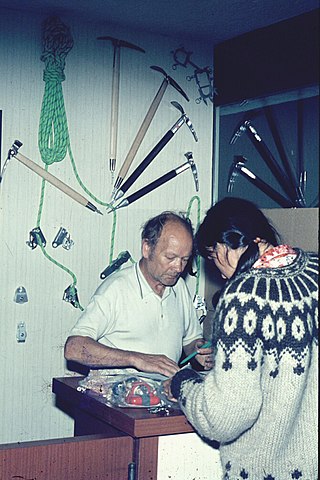
Fernand Petzl was a caver and manufacturer of outdoor equipment under the brand name Petzl.
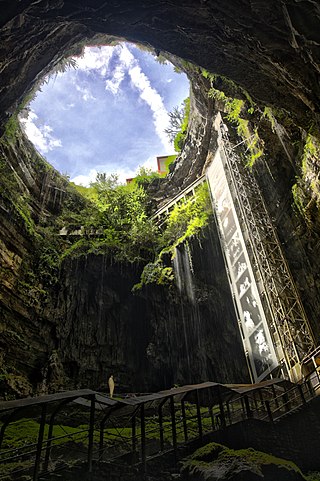
The Padirac Chasm is a cave located near Gramat, in the Lot department, Occitanie region, France.

A pit cave, shaft cave or vertical cave—or often simply called a pit and pothole or pot ; jama in Slavic languages scientific and colloquial vocabulary —is a type of cave which contains one or more significant vertical shafts rather than being predominantly a conventional horizontal cave passage. Pits typically form in limestone as a result of long-term erosion by water. They can be open to the surface or found deep within horizontal caves. Among cavers, a pit is a vertical drop of any depth that cannot be negotiated safely without the use of ropes or ladders.

Great Douk Cave is a shallow cave system lying beneath the limestone bench of Ingleborough in Chapel-le-Dale, North Yorkshire, England. It is popular with beginners and escorted groups, as it offers straightforward caving, and it is possible to follow the cave from where a stream emerges at a small waterfall to a second entrance close to where it sinks 600 yards (549 m) further up the hill. It lies within the Ingleborough Site of Special Scientific Interest.

The British Cave Research Association (BCRA) is a speleological organisation in the United Kingdom. Its object is to promote the study of caves and associated phenomena, and it attains this by supporting cave and karst research, encouraging original exploration, collecting and publishing speleological information, maintaining a library and organising educational and scientific conferences and meetings.
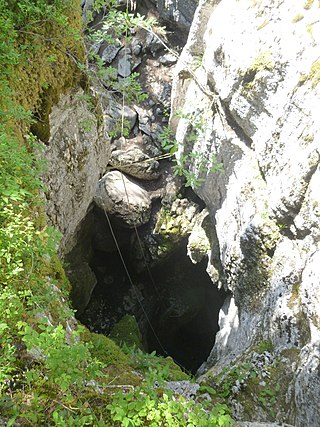
The Gouffre Berger is a cave in the French alps within the commune of Engins high on the Vercors Plateau. It was discovered on 24 May 1953 by Joseph Berger, Georges Bouvet, Ruiz de Arcaute and Marc Jouffrey. From 1953 to 1963, it was regarded as the deepest cave in the world at −1,122 metres (−3,681 ft), relinquishing this title to the previous contender, Pierre Saint Martin, in 1964, after further exploration. The Gouffre Berger is now ranked 39th deepest cave in the world, and the 4th in France.

Recreational caving in the United Kingdom dates back to the mid-19th century. The four major caving areas of the United Kingdom are North Yorkshire, South Wales, Derbyshire, and the Mendips. Minor areas include Devon, North Wales, and the Scottish Highlands.

Leck Fell is a Site of Special Scientific Interest in Lancashire, England. An area of typically heavily grazed open moorland of rough grass and remnant patches of heather with little or no tree cover, it is characterised by the virtual absence of surface drainage and an extensive subterranean drainage network resulting in cave systems and numerous sinkholes. It surrounds the high point of Gragareth 627 metres (2,057 ft) between Leck Beck and Kingsdale.
The Circolo Speleologico Romano (CSR) is an Italian, non-profit speleological organization dedicated to the exploration, research, and conservation of caves. The CSR is one of the oldest caving groups in Italy. Its activity has contributed to the birth and the increase of the Italian Speleology
The Yorkshire Ramblers' Club (YRC) is the second-oldest mountaineering club in England, the oldest being the Alpine Club.
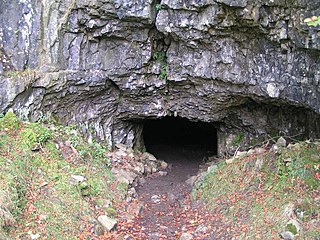
Yordas Cave is a solutional cave in Kingsdale, North Yorkshire, England. It has been renowned since the eighteenth century as a natural curiosity, and was a show cave during the nineteenth century. It is now a popular destination for cavers, walkers, and outdoor activity groups.

The Three Counties System is a set of inter-connected limestone solutional cave systems spanning the borders of Cumbria, Lancashire and North Yorkshire in the north of England. The possibility of connecting a number of discrete cave systems in the area to create a single super-system that spans the county borders was first proposed by Dave Brook in 1968, and it was achieved in 2011. The system is currently about 90 kilometres (56 mi) long, making it the longest in the UK and the thirty-fourth longest in the world, and there continues to be scope for considerably extending the system.
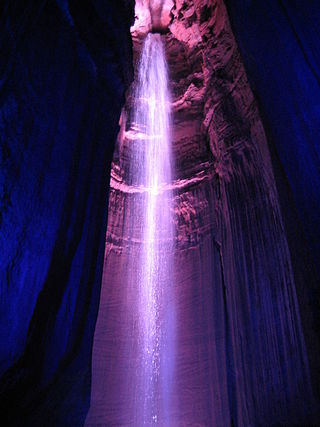
A subterranean waterfall, tierous waterfall, or underground waterfall is a waterfall located underground, usually in a cave or mine. They are a common feature in cave systems where there are vertical or near vertical geological structures for the weathering process to exploit, and sufficient gradient between the sink and the rising. Notable examples include Ruby Falls, 44 metres (144 ft) high, in Chattanooga, Tennessee and Gaping Gill in the Yorkshire Dales, UK with a fall of 98 metres. The highest known subterranean waterfall is in Vrtoglavica Cave in Slovenia, and is at least 400 metres (1,300 ft).
YSS is Young–Simpson syndrome, a rare congenital disorder.

The Long Kin East Cave - Rift Pot system is a limestone cave system on the southern flanks of Ingleborough, North Yorkshire in England lying within the designated Ingleborough Site of Special Scientific Interest. Long Kin East Cave starts as a long meandering stream passage but then plummets down a 58-metre (190 ft) deep shaft when it meets a shattered fault into which Rift Pot also descends. At the bottom, the stream flows through some low canals and sumps, to eventually emerge at Austwick Beck Head in Crummackdale.
David (Dave) Heap was largely responsible for the opening up and development of caving and potholing in Northern Norway in the 1960s and 1970s. He led a number of speleological expeditions not only to Norway but the French Pyrenees and to Greece. He was the author of the now classic caving book Potholing Beneath the Northern Pennines.
References
- "YSS 1 Journal of the Yorkshire Subterranean Society". YSS 1. 1 (1). 1977.
- "YSS 2 Journal of the Yorkshire Subterranean Society". YSS 2. 1 (1). 1979.
- "YSS 3 Journal of the Yorkshire Subterranean Society". YSS 3. 1 (1): 73. 1994.